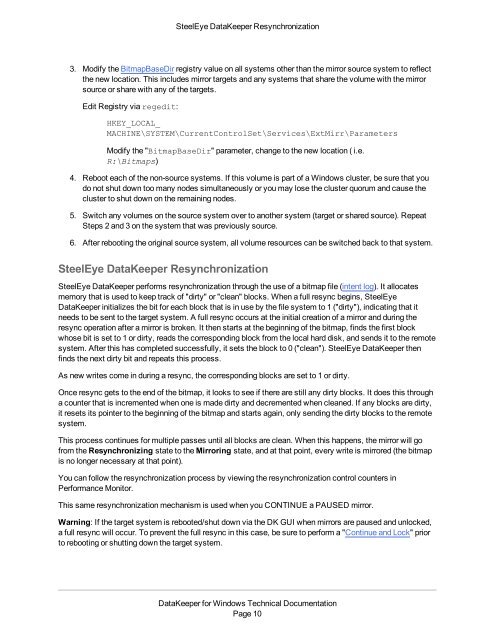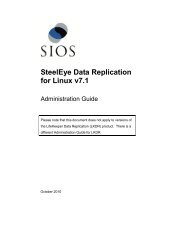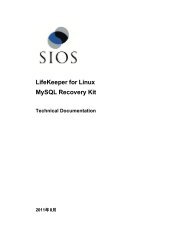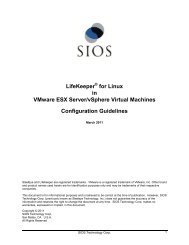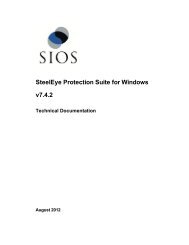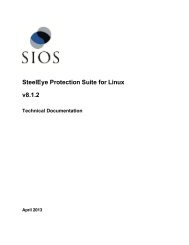DataKeeper for Windows All Documentation - SIOS
DataKeeper for Windows All Documentation - SIOS
DataKeeper for Windows All Documentation - SIOS
You also want an ePaper? Increase the reach of your titles
YUMPU automatically turns print PDFs into web optimized ePapers that Google loves.
SteelEye <strong>DataKeeper</strong> Resynchronization3. Modify the BitmapBaseDir registry value on all systems other than the mirror source system to reflectthe new location. This includes mirror targets and any systems that share the volume with the mirrorsource or share with any of the targets.Edit Registry via regedit:HKEY_LOCAL_MACHINE\SYSTEM\CurrentControlSet\Services\ExtMirr\ParametersModify the "BitmapBaseDir" parameter, change to the new location ( i.e.R:\Bitmaps)4. Reboot each of the non-source systems. If this volume is part of a <strong>Windows</strong> cluster, be sure that youdo not shut down too many nodes simultaneously or you may lose the cluster quorum and cause thecluster to shut down on the remaining nodes.5. Switch any volumes on the source system over to another system (target or shared source). RepeatSteps 2 and 3 on the system that was previously source.6. After rebooting the original source system, all volume resources can be switched back to that system.SteelEye <strong>DataKeeper</strong> ResynchronizationSteelEye <strong>DataKeeper</strong> per<strong>for</strong>ms resynchronization through the use of a bitmap file (intent log). It allocatesmemory that is used to keep track of "dirty" or "clean" blocks. When a full resync begins, SteelEye<strong>DataKeeper</strong> initializes the bit <strong>for</strong> each block that is in use by the file system to 1 ("dirty"), indicating that itneeds to be sent to the target system. A full resync occurs at the initial creation of a mirror and during theresync operation after a mirror is broken. It then starts at the beginning of the bitmap, finds the first blockwhose bit is set to 1 or dirty, reads the corresponding block from the local hard disk, and sends it to the remotesystem. After this has completed successfully, it sets the block to 0 ("clean"). SteelEye <strong>DataKeeper</strong> thenfinds the next dirty bit and repeats this process.As new writes come in during a resync, the corresponding blocks are set to 1 or dirty.Once resync gets to the end of the bitmap, it looks to see if there are still any dirty blocks. It does this througha counter that is incremented when one is made dirty and decremented when cleaned. If any blocks are dirty,it resets its pointer to the beginning of the bitmap and starts again, only sending the dirty blocks to the remotesystem.This process continues <strong>for</strong> multiple passes until all blocks are clean. When this happens, the mirror will gofrom the Resynchronizing state to the Mirroring state, and at that point, every write is mirrored (the bitmapis no longer necessary at that point).You can follow the resynchronization process by viewing the resynchronization control counters inPer<strong>for</strong>mance Monitor.This same resynchronization mechanism is used when you CONTINUE a PAUSED mirror.Warning: If the target system is rebooted/shut down via the DK GUI when mirrors are paused and unlocked,a full resync will occur. To prevent the full resync in this case, be sure to per<strong>for</strong>m a "Continue and Lock" priorto rebooting or shutting down the target system.<strong>DataKeeper</strong> <strong>for</strong> <strong>Windows</strong> Technical <strong>Documentation</strong>Page 10


